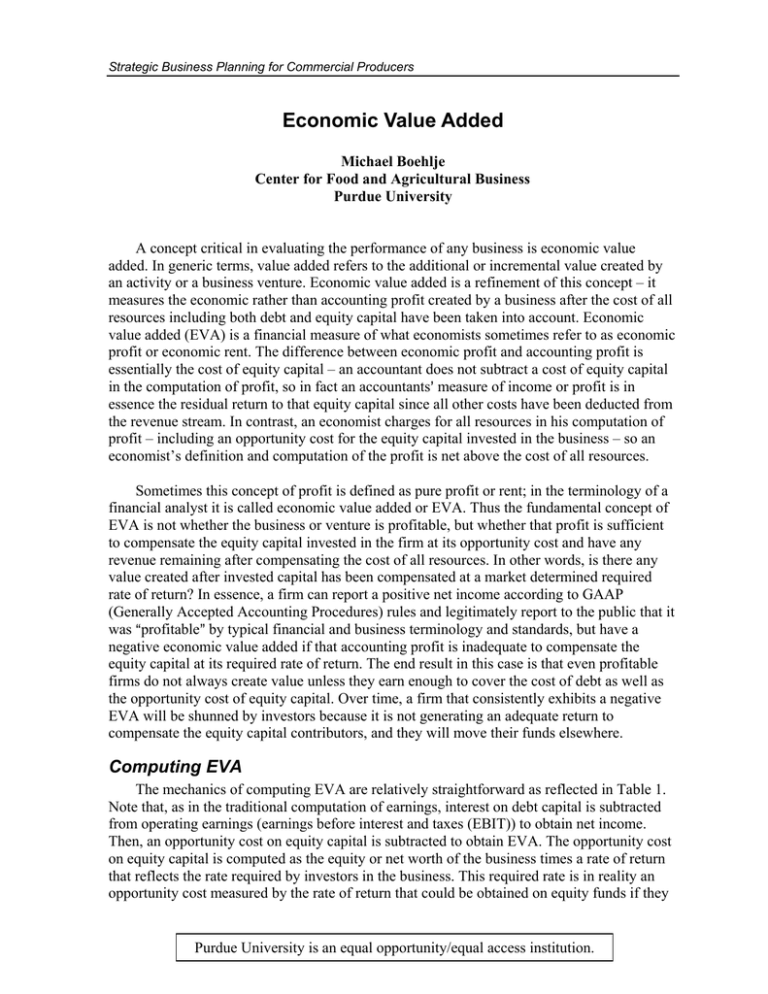Economic Value Added
advertisement

Strategic Business Planning for Commercial Producers Economic Value Added Michael Boehlje Center for Food and Agricultural Business Purdue University A concept critical in evaluating the performance of any business is economic value added. In generic terms, value added refers to the additional or incremental value created by an activity or a business venture. Economic value added is a refinement of this concept – it measures the economic rather than accounting profit created by a business after the cost of all resources including both debt and equity capital have been taken into account. Economic value added (EVA) is a financial measure of what economists sometimes refer to as economic profit or economic rent. The difference between economic profit and accounting profit is essentially the cost of equity capital – an accountant does not subtract a cost of equity capital in the computation of profit, so in fact an accountants= measure of income or profit is in essence the residual return to that equity capital since all other costs have been deducted from the revenue stream. In contrast, an economist charges for all resources in his computation of profit – including an opportunity cost for the equity capital invested in the business – so an economist’s definition and computation of the profit is net above the cost of all resources. Sometimes this concept of profit is defined as pure profit or rent; in the terminology of a financial analyst it is called economic value added or EVA. Thus the fundamental concept of EVA is not whether the business or venture is profitable, but whether that profit is sufficient to compensate the equity capital invested in the firm at its opportunity cost and have any revenue remaining after compensating the cost of all resources. In other words, is there any value created after invested capital has been compensated at a market determined required rate of return? In essence, a firm can report a positive net income according to GAAP (Generally Accepted Accounting Procedures) rules and legitimately report to the public that it was Aprofitable@ by typical financial and business terminology and standards, but have a negative economic value added if that accounting profit is inadequate to compensate the equity capital at its required rate of return. The end result in this case is that even profitable firms do not always create value unless they earn enough to cover the cost of debt as well as the opportunity cost of equity capital. Over time, a firm that consistently exhibits a negative EVA will be shunned by investors because it is not generating an adequate return to compensate the equity capital contributors, and they will move their funds elsewhere. Computing EVA The mechanics of computing EVA are relatively straightforward as reflected in Table 1. Note that, as in the traditional computation of earnings, interest on debt capital is subtracted from operating earnings (earnings before interest and taxes (EBIT)) to obtain net income. Then, an opportunity cost on equity capital is subtracted to obtain EVA. The opportunity cost on equity capital is computed as the equity or net worth of the business times a rate of return that reflects the rate required by investors in the business. This required rate is in reality an opportunity cost measured by the rate of return that could be obtained on equity funds if they Purdue University is an equal opportunity/equal access institution. were invested elsewhere. A positive EVA means the firm is generating a return to invested capital that exceeds the direct (i.e. interest) and opportunity cost of that invested capital; a negative EVA means that the firm did not generate a sufficient return to cover the cost of its debt and equity capital. Table 1. Calculating EVA EBIT (Earnings Before Interest and Taxes) Less Equals Less Equals Interest Net Income Cost of Equity Capital EVA Improving EVA What insight does EVA provide about financial performance of a business and how to improve it? First, like any financial measure, the trend may be more valuable than the absolute value of EVA. Even if EVA is positive, a declining EVA suggests that financial performance is deteriorating over time, and if this trend continues EVA will become negative and financial performance unacceptable. A negative EVA indicates that the firm is not compensating its capital resources adequately, and corrective action should be considered if this negative EVA persists over time. So what are some corrective actions? First, operating performance with respect to operating profit margins or asset turnover ratios could be improved to generate more revenue without using more capital. Second, the capital invested in the business might be reduced by selling under-utilized assets; this strategy will simultaneously improve operating performance through a higher asset turnover ratio, as well as a reduced capital charge against those earnings because of a reduced debt or equity capital investment. Third, redeploy the capital invested to projects and activities that have higher operating performance than the current projects or investments are exhibiting. And fourth, if the business is not highly leveraged, change the capital structure by substituting lower cost debt for higher cost equity. Although this last strategy will decrease net income because of the higher interest cost, it will improve the EVA of the business because the total cost of debt and equity is reduced, and EVA measures the value created after all costs of capital (debt and equity) have been taken into account. 2


